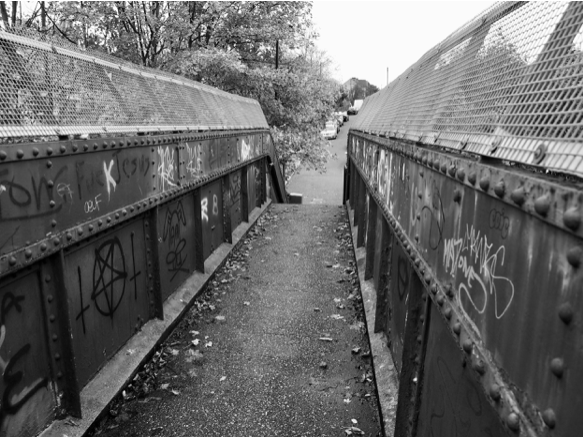It’s time for the annual musings known as Shadows and Reflections. Since so many of our lives were lived in thematic overlap in 2020, we’ve asked our contributors and friends to focus on the small, strange and specific as they look back over the last 12 months. Today it’s the turn of Tom Bolton.

The footbridge carrying Canterbury Grove from West Norwood across the railway line to Tulse Hill is a timeslip. It is a narrow, metal structure with steep steps up either side, of the kind that seem to belong to an emptier London of the 1970s. The bridge cuts Canterbury Grove, otherwise a steep street of an ordinary width, in two. There has been a bridge here since the 19th century when the railway was first dug out, originally a wooden structure as the name of the adjacent 1980s houses, Wooden Bridge Terrace, makes clear. On the opposite site a terrace of three remaining Victorian houses is part of the timeslip, still existing in an industrial era of works and workers, housed opposite their employment. All the factories are now gone, including the Meisenbach Works which offered colour printing before the First World War, and the housing that has replaced them is of variable quality.
In 1980, the director Patrick Keiller made a short, enigmatic film called Norwood which, through an unnamed narrator and shots of Streatham and West Norwood streets, told a bleak story of crime and revenge in a strangely detached voiceover. During Spring 2020 Jo and I, like many others, spent a lot of time at home, venturing out only once a day. Our world shrank to a circumference defined by a lunchtime or an evening walk from my flat in Streatham. Places on the horizon – the towers at Colliers Wood, Sutton and Tolworth, the Croydon cluster, the green fringe of Wimbledon Common, the far North Downs beyond Caterham – were out of reach. Forced to focus on what was near at hand, I became a little obsessed with this film, the only one I had ever seen that was set among the streets in which we lived.
Our flat is on the border between south west and south east, measured by postcodes, just inside SW16. A short distance away the SE postcodes begin between Streatham and West Norwood. Logically, both belong in the missing S postcode. Just as north London has N codes, south London originally had S codes too. Thanks to Anthony Trollope, in his day job as a surveyor for the Post Office, S was abolished in 1866 along with NE, as a means of saving money. Somehow, it leaves south London a little undefined, and the territory between Streatham and West Norwood is off the map for almost anyone who does not live nearby. It has no centres, no pubs and hardly any shops – just a steep ridge stacked with Victorian terraces, patches of woodland and railway voids, with remarkable views to the north, the east and the west.
The voice in Norwood is Keiller’s own, but his original intention was for Vincent Price to play the role, a plan prevented by availability problems. It never happened, but the idea of the voice of horror becoming the voice of unknown Norwood is tantalising. The bridge is a crossing point over the railway to the narrator’s former flat, but he notes that while walking the streets one ‘…may trip and, anticipating concussion, fall rather into the realisation that one is truly somewhere else.’ He is, in fact, already dead, and the bridge leads from one world to another, thinly separating the real from the imagined. There is no ferryman to make the crossing official or to provide assurance of what might happen on the other side. You have to cross this bridge at your own risk. We take it on the way home from the pub near Tulse Hill and, so far, have always reached the other side.